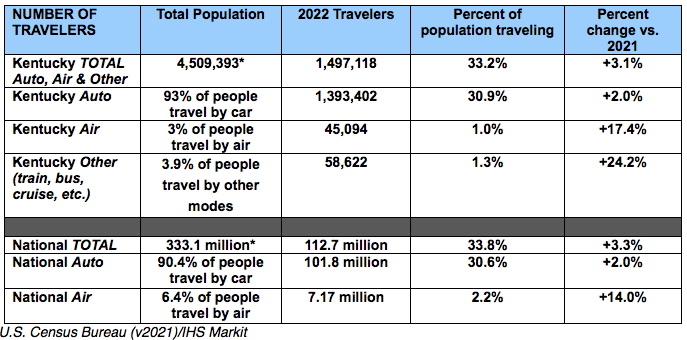‘Tis the season to travel, and AAA estimates 112.7 million people will journey 50 miles or more away from home from December 23 to January 2. That’s an increase of approximately 3 percent, or 3.6 million people, over last year but still down by about 5 percent when compared to pre-pandemic numbers. 2022 is expected to be the third busiest year for holiday travel since AAA began tracking in 2000.
“This year, the holiday travel period will be extended due to Christmas Day and New Year’s Day falling on Sundays,” says Lori Weaver Hawkins, public and government affairs manager, AAA Blue Grass. “With hybrid and remote work schedules, we are seeing more people take long weekends to travel because they can work remotely at their destination and be more flexible with the days they depart and return.”

AAA photos
1.5 Million Kentuckians Predicted to Travel
AAA predicts that 1.5 million Kentuckians will be traveling 50 miles or further from home this end-of-year holiday season. The number of travelers in the Commonwealth mean that about 1 out of every 3 residents will be enjoying the holidays away from home, mirroring national ratios. About 93 percent of Kentucky’s travelers will be taking to the roadways, while about 3 percent will be taking to the skies.
2022 Projected Year-End Travelers – Kentucky

Auto Travel and Gas Prices
Nearly 102 million Americans will drive to their holiday destinations, including 1.4 million Kentuckians. This holiday season will see an additional 2 million people traveling nationally by auto, a 2 percent increase, compared to 2021. Travel by vehicle this year is on par with 2018 but shy of 2019 when 108 million Americans drove out of town for the holidays, the highest year on record.
“Gas prices have been on a roller coaster ride throughout 2022, but have recently settled down to levels below 2021 average prices, just in time for the holidays,” Weaver Hawkins states.
In fact, the national average on Thursday was $3.19, a 13-cent dip from last week and 12 cents less than year ago prices. Kentucky’s average also fell to $2.90, 13 cents less than a week ago and 8 cents less than last year.
“As demand remains low and stocks grow, drivers will likely continue to see pump prices decline as we approach the year-end holiday travel period,” Weaver Hawkins adds.
Road travelers are reminded to ensure their vehicle maintenance is up to date before heading down the highway.
“Motorists should also stay aware of changing road conditions, especially this time of year,” Weaver Hawkins reminds. “Weather can change quickly, leading to icy or snowy conditions.”
AAA offers the following tips for winter driving:
• Drive slowly. Every maneuver takes longer on snow-covered roads. Be aware of traffic ahead and slow down even more if you start to see brake lights or fish-tailing cars. Accelerate and decelerate slowly. Always buckle up. If you absolutely don’t need to go out, stay home.
• Don’t follow other vehicles as closely as you would when driving in clear, dry conditions.
Your vehicle cannot slow down as quickly. Increase following distances to 8 seconds or more.
• Don’t be abrupt with your steering, acceleration and braking. Your vehicle’s balance can be negatively affected, increasing the chance of experiencing a skid. Always steer, accelerate and brake smoothly. Avoid unnecessary lane changes, reducing the chance of hitting a patch of ice.
• Avoid braking on icy roads. Try to brake well ahead of stop signs and traffic lights, preferably in areas of clear pavement. Whether you have antilock brakes or not, keep the heel of your foot on the floor and use the ball of your foot to apply firm, steady pressure on the brake pedal.

• Don’t stop if you can avoid it. There’s a big difference in the amount of inertia it takes to start moving from a full stop versus how much it takes to get moving while still rolling. If you can slow down enough to keep rolling until a traffic light changes, without getting close to vehicles ahead of you, do it.
• Don’t power up hills. Applying extra gas on snow-covered roads just starts your wheels spinning. Try to get a little inertia going before you reach the hill and let that inertia carry you to the top rather than hard acceleration. Do not stop on your way up the hill. As you reach the crest of the hill, reduce your speed and proceed downhill as slowly as possible.
• Don’t hit the brakes if you start to skid. If you are approaching a patch of ice, brake during your approach. Applying pressure to your brakes while on the ice will only throw you into a skid. If you do start to skid, ease off of the accelerator or brake and steer in the direction you want the front of the car to go.
• Never use cruise control on slippery roads. Cruise control will cause you to lose the ability to transfer more weight to the front tire by simply lifting off the accelerator. A driver should always be in full control of their vehicle during poor road conditions.
• If you get stuck in the snow or go off the road, stay with your vehicle. Don’t over-exert yourself, be visible, clear the exhaust pipe, stay warm and conserve fuel.
Weaver Hawkins also advises drivers to keep a winter emergency kit in their vehicle at all times. The kit should include flares or reflective triangles, an ice scraper with brush, deicer, flashlight with extra batteries, snow shovel, abrasive material or traction mats, jumper cables, extra warm clothing and blankets, first-aid kit and basic toolkit. Many of the winter emergency items listed above―plus pre-assembled winter emergency kits―are available in the online store at AAA.com.
Travelers should also bring water and snacks for all vehicle occupants, including pets.
Air Travel and Other Modes
Nationally, air travel will see a 14% increase over last year, with nearly 7.2 million Americans expected to fly. Flights and airports will be packed this holiday season, reminiscent of pre-pandemic days.
Demand for flights has surged despite higher airline ticket prices. AAA expects the number of people taking holiday flights this year will come close to matching 2019 when 7.3 million Americans traveled by air.
“The TSA reports screening more than 2.5 million people at U.S. airports on the Sunday after Thanksgiving,” adds Ali. “That’s the highest number of travelers that screeners have seen since the start of the pandemic and a sure sign that air travel is getting back closer to normal.”
Other modes of transportation are also rebounding in a big way. AAA estimates travel by bus, rail, and cruise ship will rise to 3.6 million this holiday season, a 23% increase from last year and nearly 94% of 2019’s volume.

Busiest Corridors and Best/Worst Times to Travel
INRIX, a provider of transportation analytics and insights, expects the most congested days on the road to be the Friday before Christmas, December 23, as well as December 27 and 28. Monday, January 2, is also expected to be a busy day on the roads, as travelers mix with commuters. In major metros, especially in Los Angeles and New York City, drivers could experience double the typical delays. Nationwide, drivers could see travel times up to 25% longer.
With pre-pandemic levels of travelers hitting the road this holiday, drivers must be prepared for delays in and around major metro areas, with Tuesday, December 27 expected to be the nation’s worst day to travel. Travelers should avoid traveling during peak commuting hours. If schedules allow, leave bright and early or after the afternoon commute.”
BEST AND WORST TIMES to TRAVEL BY CAR

Holiday Forecast Methodology: A Brief Overview
Travel Forecast
In cooperation with AAA, S&P Global Market Intelligence developed a unique methodology to forecast actual domestic travel volumes. The economic variables used to forecast travel for the current holiday are leveraged from S&P Global Market Intelligence’s proprietary databases. These data include macroeconomic drivers such as employment, output, household net worth, asset prices, including stock indices, interest rates, housing market indicators, and variables related to travel and tourism, including gasoline prices, airline travel, and hotel stays. AAA and S&P Global Market Intelligence have quantified holiday travel volumes going back to 2000.
Historical travel volume estimates come from DK SHIFFLET’s TRAVEL PERFORMANCE/Monitor SM. The PERFORMANCE/Monitor SM is a comprehensive study measuring the travel behavior of U.S. residents. DK SHIFFLET contacts over 50,000 U.S. households each month to obtain detailed travel data, resulting in the unique ability to estimate visitor volume and spending, identify trends and forecast U.S. travel behavior — all after the trips have been taken.
The travel forecast is reported in person trips. In particular, AAA and S&P Global Market Intelligence forecast the total U.S. holiday travel volume and expected mode of transportation. The travel forecast presented in this report was prepared for the week of November 15, 2022.
Year-End Holiday Travel Period
For purposes of this forecast, the year-end holiday travel period is defined as the 11-day period from Friday, December 23 to Monday, January 2. This period is the same length as the 2021/2022 year-end travel period.
The year-end holiday travel period can range from 10 to 13 days, depending on which day of the week Christmas Day and New Year’s Day fall. All the year-end holiday periods contain two weekends.






















